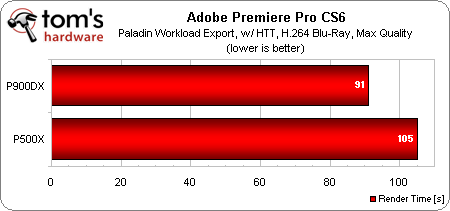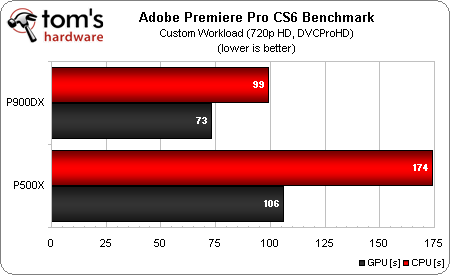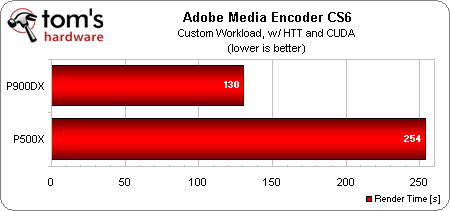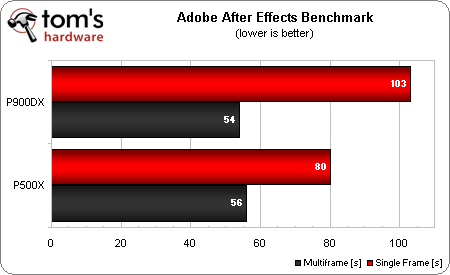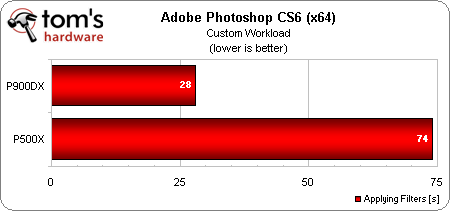iBuyPower P500X And P900DX Workstations, Reviewed
Armed with updated workstation benchmarks, we have two systems from iBuyPower in the lab today: a $2,000 quad-core entry-level rig, and an $8,000 sixteen-core behemoth. With $6,000 separating the two, is the performance spread really what you'd expect?
Adobe Creative Suite 6
Adobe’s Creative Suite 6 (CS6) uses CUDA, OpenCL, and OpenGL acceleration to various degrees. Everything else is addressed by host processing power.
Adobe Premiere Pro CS6
We have two tests in Premiere Pro, one using the Adobe-supplied Paladin benchmark, and the other using our own custom test.
The P900DX demonstrates only a 15% improvement over the P500X in this CUDA-accelerated Paladin test. That's a little disappointing when you consider the P900DX’s Quadro 4000 enjoys 33% more CUDA cores and more than two times as much memory bandwidth.
Our in-house Premiere Pro test shows a 45% difference between the two machines using GPU-based compute, and a 75% difference when we lean on the CPUs. It should also be noted that the difference between the CPU and GPU tests on these machines is not as significant as we’ve seen when testing workstations in the past.
Since these machines have the exact same hard disks (and because the benchmarks were run from the conventional drives, not the SSDs), we believe the more limited performance delta is a storage bottleneck. The faster clock speed of the P500X's Quadro 2000 also helps make up for the lesser number of CUDA cores.
We tested our theory by running the Tom’s Hardware Premiere Pro test entirely from a RAM drive on the P900DX. Performance was significantly better up until about 75% into the render when the RAM drive filled up. Those results are not reproduced here because we simply couldn't make a RAM drive large enough to complete the test. Nevertheless, our little experiment illustrates how important it is to build a well-balanced workstation. And right now, storage is one of the most glaring subsystems overlooked.
Get Tom's Hardware's best news and in-depth reviews, straight to your inbox.
The Paladin test results are likely closer together because they require that the machine pull in multiple streams of video simultaneously, which will push both speed and random access times for the video drives.
Adobe Media Encoder CS6
The Adobe Media Encoder test takes the footage from our custom Premiere test and renders it down to a 720p H.264-encoded file for Blu-ray distribution. Despite the system’s storage limitations (or perhaps because of it) the P900DX is almost twice as fast as the P500X.
Adobe After Effects CS6
Time for the After Effects test results, which have been best described as anomalous.
Single-frame After Effects performance is limited by clock speed and architecture. So, the Ivy Bridge-based P500X actually comes out ahead, despite its reduced core count. In multi-frame mode, the P900DX barely squeaks out a lead over the P500X.
We retested several times using various settings to try isolating different variables. The published result is with After Effects running its multi-frame processing on five processor cores. Enabling any additional cores results in a completely insignificant decrease to render time. For example, the sixth core only shaves one second off the total render time. What's more, continuing to add cores eventually results in increased render times, purportedly as each core gets less system memory to work with.
What we can say for sure is that if you do a lot of heavy After Effects work, you're better off spending money on a few render nodes rather than buying an expensive dual-socket motherboard and pair of high-end CPUs. Even using a second P500X as a render node (an expensive render node) would mean a significant improvement in render time (likely not 2x, but somewhere on the order of 1.75x would not be unexpected) for only twice the cost.
Adobe Photoshop CS6
The Photoshop test we're currently using is CPU-based, and does not significantly make use of any OpenGL or OpenCL features that were added in CS6. Therefore, this test greatly benefits from the additional processor cores and memory bandwidth of the P900DX, showing a 2.64x increase over the P500X, as well as the fastest time we’ve ever seen in the Photoshop test. Keep in mind this test loads and applies six filters to a 69 MB TIFF image, but does not test brushstrokes or other UI interactivity which cannot be recorded in a Photoshop action.
Current page: Adobe Creative Suite 6
Prev Page Synthetics: Sandra And Euler3d Next Page 3ds Max: V-Ray And iray-
sprucegroose The P900DX would be about $6500 for the parts alone. It also comes with warranty, and if you are the type of person using it, the time building it and repairing it might offset the price difference. On the other hand, you could put in better components for the same price.Reply -
manitoublack We've got the Quadro 4000's at work and they're junk. GTX280 is faster and they were released in 2008. I pulled mine and installed my old GTX295, made a huge difference using the mine modelling software.Reply
Quadrao 4000 was all stutters, GTX 295 is buttery smooth. -
csf60 manitoublackWe've got the Quadro 4000's at work and they're junk. GTX280 is faster and they were released in 2008. I pulled mine and installed my old GTX295, made a huge difference using the mine modelling software.Quadrao 4000 was all stutters, GTX 295 is buttery smooth. that's because workstation cards are not meant to be fast at rendering frames. They are fast at doing many simple batch calculations like ray tracing, fluid movement or video editing.Reply -
j2j663 manitoublackWe've got the Quadro 4000's at work and they're junk. GTX280 is faster and they were released in 2008. I pulled mine and installed my old GTX295, made a huge difference using the mine modelling software.Quadrao 4000 was all stutters, GTX 295 is buttery smooth.Reply
This is like someone complaining that a screwdriver is really bad at pounding in nails. Learn to use the right tools for the job at hand. -
I'm curious about the After Effects performance. What were your memory settings when rendering multiple frames simultaneously?Reply
-
Draven35 they varied, I had to set them between 3gb and the minimum in order to the the maximum number of cores. I have a working theory on the AE problem that i will test next opportunity.Reply -
Wow, odd. Anywhere I could get an update on your progress once you test your hypothesis? I'd love to figure out what is causing that result. It should be destroying that benchmark.Reply
